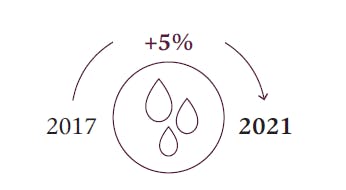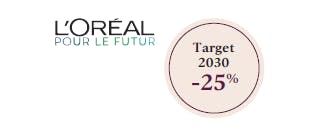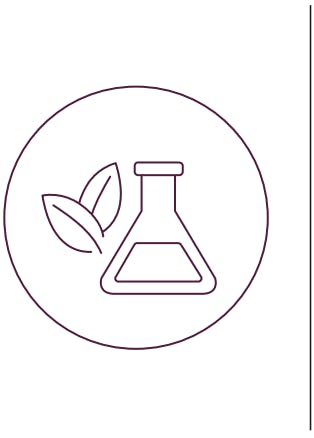WATER CONSUMPTION LINKED TO THE USE
OF THE PRODUCTS

(water consumption per liters/kg of formulas sold)

GREENHOUSE GAS EMISSIONS LINKED TO USE OF THE PRODUCTS

(TCO2eq./kg of formulas sold)

B/ Respect for biodiversity
Giving preference to the use of sustainably sourced renewable raw materials
The Group’s constant concern regarding the sourcing of its raw materials is, over and above quality considerations, to guarantee the sustainability of resources.
In 2010, the signatory countries to the Convention on Biological Diversity adopted the Nagoya Protocol, aimed at regulating access to the genetic resources of a given region and the fair sharing of benefits arising from the use of those resources.
Conscious of these issues well before the Nagoya Protocol came into force, L’Oréal’s Research Department has continuously strived, since 2005, to adopt an approach aimed at securing its sourcing channels for the future to respond to the issues of sustainable use of biodiversity. To do so, the Group gives preference, in particular, to the use of renewable raw materials(1) and ensures that they are responsibly sourced. L’Oréal has adopted green chemistry principles to promote the use of renewable raw materials, to design products serving to reduce waste and preserve the water cycle. For more than ten years, green chemistry has been a catalyst for L’Oréal’s sustainable innovation policy. In the broadest sense, green chemistry aims to prevent upstream pollution and to combat the use and contamination of the environment at source. The increasing use of plant-based ingredients presents risks in terms of supply related to the consequences of climate change (availability and price), and can also result in environmental consequences through the cultivation of the crops that produce these ingredients (deforestation, soil depletion, consequences on biodiversity, for instance).

In 2021, among the raw materials newly referenced by the Group 63% in number were renewable and 40% in number respected green chemistry
| Products marketed in 2021 with a proportion of renewable raw materials above 98% | |||
|---|---|---|---|
| Blowout solid serum | Softsheen-Carson | ||
| Hair spa hair tonic | L’Oréal Professionnel | ||
| Hydra floral bright essence | Decleor | ||
| Garnier Fructis Curl Nourish Wonder Oil | Garnier | ||
In 2021, Biotherm updated the formula for its Aquasource Hyalu Plump Gel hydrating face gel, increasing the percentage of renewable materials from 53% to 91% with a pot made of 40% recycled glass in recycled and recyclable paper packaging without cellophane.
The Group has also set up a Green Sciences programme to drive change in its portfolio of raw materials and formulas. This is achieved through the development of ingredients with a favourable environmental profile, by minimising environmental impacts and using eco-friendly processing methods.
(1)This means that the carbon content is primarily of plant origin.
